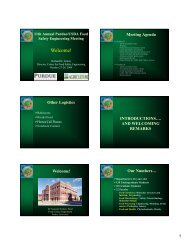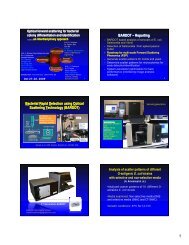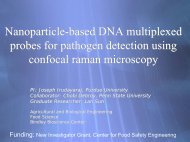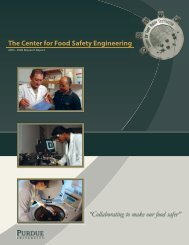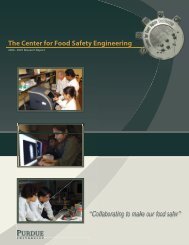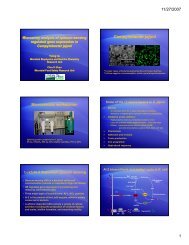Cousin and WoloshukImmunocapture real-time PCR to detectmycotoxigenic mold spores in grainsInvestigators: Maribeth A. Cousin (Department of <strong>Food</strong> Science), Charles P. Woloshuk (Department of Botany and Plant Pathology)Project RationaleCurrently, there are few commercial rapid methods to detectmolds and their spores in agricultural commodities, grains,and foods. In previous research, a protocol was developed toidentify Fusarium species that produce two major mycotoxins:fumonisins and trichothecenes. This antibody-based method wasdeveloped <strong>for</strong> Fusarium species to capture antigens of thesemycotoxin-producers, which were then combined with a realtimePCR assay that was based on species-specifi c and genusspecific primers to identify the Fusarium species. The effi ciencyof spore capture was limited in the previous research becausethe Fusarium spores were diffi cult to lyse <strong>for</strong> DNA release. Weproposed this new research to help resolve that limitation by:(1) studying physical, enzymatic, and mechanical methods tobreak mold spores to release DNA <strong>for</strong> use in real-time PCR, and(2) incorporating the method developed in objective 1 into theimmunocapture-qPCR method that uses antibodies producedagainst F. graminearum and F. verticillioides and primers that arespecifi c <strong>for</strong> the Tri6 gene involved in trichothecene biosynthesisand <strong>for</strong> the Fum1 gene involved in fumonisin biosynthesis. Inaddition, we proposed to develop a library of PCR primers toother mycotoxigenic genera (Aspergillus that produce afl atoxinsand ochratoxin and Penicillium that produce ochratoxin andpatulin) <strong>for</strong> real-time PCR, and to use these primers in multiplexPCR <strong>for</strong>mats to detect all major mycotoxin producers in thesame assay. Antibodies to afl atoxin-producing molds andPenicillium species were produced in earlier research.• Determine the specifi city and sensitivity ofprimer sets and multiplex <strong>for</strong>mat.• Optimize the capture of mold spores and release of DNAused to detect Fusarium species in foods and grains.Project HighlightsA procedure was developed and optimized using lyticase(Sigma: 5263) to extract DNA from conidia of Fusariumgraminearum and Fusarium verticillioides <strong>for</strong> use in real-timequantitative PCR (qPCR). This was important because themethods used to extract DNA from other microorganisms do notwork <strong>for</strong> fi lamentous fungi. Lyticase was mixed with buffer andmercaptoethanol, incubated at 37°C <strong>for</strong> four or six hours <strong>for</strong> F.graminearum and F. verticillioides, respectively, and shaken ina bead-beater to physically disrupt the conidia be<strong>for</strong>e analyzingwith real-time qPCR. By this method, a minimum of 10 conidiaof F. graminearum and 1000 conidia of F. verticillioides could bedetected.Project Objectives• Develop primer sets to detect Aspergillusand Penicillium species.• Experiment with different methods to breakmold spores of Fusarium species.6<strong>Center</strong> <strong>for</strong> <strong>Food</strong> <strong>Safety</strong> <strong>Engineering</strong>“This antibody-based method was developed <strong>for</strong> Fusarium species to capture antigens ofthese mycotoxin-producers, which were then combined with a real-time PCR assay...”
Irudayaraj, Mauer, DebRoy and FratamicoDetection of foodborne pathogens via an integratedspectroscopy and biosensor-based approachInvestigators: Joseph Irudayaraj (Department of Agricultural and Biological <strong>Engineering</strong>), Lisa Mauer (Department of <strong>Food</strong>Science), Chitrita DebRoy (The Pennsylvania State University), Pina Fratamico (USDA)Project RationaleZoonotic pathogens such as Salmonella spp., Listeriamonocytogenes, Shiga-toxin producing Escherichia coli(including E. coli O157:H7), and Campylobacter jejuniare recognized as causes of signifi cant and sometimeslethal foodborne illnesses. Identifi cation of these microbialcontaminants is a primary food safety concern in foodproduction, processing, and retail environments. Currentdetection methods <strong>for</strong> E. coli O157:H7 require enrichment <strong>for</strong> 18to 24 hours followed by isolation, prescreening, and confi rmationwith classical biochemical methods or commercially availableassays based on ELISA, antibody precipitation, or PCR. Theseprocedures require up to four days to completely identify E. coliO157:H7. The infective dose <strong>for</strong> Salmonella strains varies withthe server, food, and person. As few as 1 to 10 cells can causeillness, and ranges from 1 to 10 7 CFU/ml of Salmonella strainshave been reported.New technologies <strong>for</strong> detecting foodborne pathogens that arerapid, sensitive, and portable with a potential <strong>for</strong> on-site detectionare needed to help ensure a safe food supply <strong>for</strong> consumers.The ultimate goal of this research was to develop a portableminiaturized infrared sensor <strong>for</strong> specifi c and sensitive detectionof foodborne pathogens. We proposed to integrate samplingand biosensor modules with Fourier trans<strong>for</strong>m infrared/Ramanspectroscopy (FTIR/raman) as well as uv-Visible near infraredspectroscopy to improve detection sensitivity and specifi city.The fi rst steps were to constitute the standardization of FTIRand raman methodologies with the most appropriate samplingsteps <strong>for</strong> sensitivity enhancement and biofunctionalizationsteps <strong>for</strong> specifi city improvement. The second phase focusedon extensive validation using food, as well as mock industrysamples, and translating the benchtop methodologies to aportable mid-infrared device.Project Objectives• Develop and standardize FTIR and raman spectroscopybasedmolecular fi ngerprints (spectra) of foodborneoutbreak strains in conjunction with samplingand regulatory validation in food matrices.• Advance infrared equipment, sampling,testing, and validation capabilities <strong>for</strong> rapididentifi cation of foodborne pathogens.Project HighlightsWe developed a FTIR and raman library of spectroscopicfi ngerprints <strong>for</strong> a total of 28 foodborne pathogenic strains.Of these, 14 were E. coli O157:H7, and two were outbreakstrains. We developed a biosensor protocol using goldnanorods to detect < 10 CFU/ml using a simple ultraviolet-visiblespectrometer. We fi nalized a procedure to per<strong>for</strong>m componentanalysis to understand further the basis and the origin of theFTIR signatures. We constructed and tested the PathoIR chipin the benchtop FTIR. The presence of three signature peaks inthe 850cm -1 to 1100 cm -1 region confi rmed binding of the targetbacteria to the chip surface. We identifi ed a portable systemwhich is twice as sensitive as the current system. This system isalready remarkably promising. However, we believe that this canbe further improved.In summary, our key accomplishment this year was thedevelopment of sensitive nanobiosensors that can providea detection limit of ~10 CFU/ml using a simple visible–nearinfraredspectrometer. The potential exists to further refi nethis technology by integrating a pathogen separation element.Hence, detection in complex mixtures could be per<strong>for</strong>medin one step. This would also facilitate the detection of multiplepathogens at a very high sensitivity level using a simplespectrometer that is af<strong>for</strong>dable and portable.“We developed a FTIR and raman library of spectroscopicfi ngerprints <strong>for</strong> a total of 28 foodborne pathogenic strains.”7<strong>Center</strong> <strong>for</strong> <strong>Food</strong> <strong>Safety</strong> <strong>Engineering</strong>



